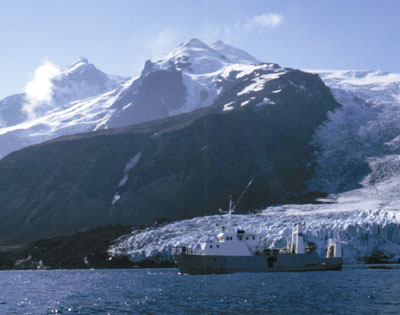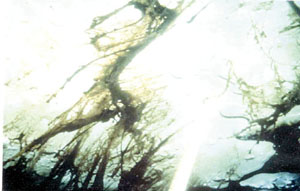The high Arctic: challenges for European biodiversity research
Sabine Cochrane,
Akvaplan-niva,
Polar Environmental Centre,
Tromsø, Norway
 |
Research activities beside a calving glacier on
the volcanic island of Javen Mayen (71oN, 8oE).
Photo B. Gulliksen.
The area of interest for European marine biodiversity research
extends northwards, beyond the Arctic circle, to approximately 80°N
(Dinter, 2001). Seen within a European perspective, the Arctic contains
a number of unique habitats and environmental conditions. Arctic marine
biodiversity is characterised by a simplicity in upper trophic levels
and highly specialised organisms. Such typical Arctic inhabitants are
polar bears, seals such as ringed and bearded seals, walrus, whales such
as the bowhead, narwhal and white whales and fish such as the polar cod.
On the underside of floating ice are specialised communities of sympagic
(ice-associated) flora and fauna, including filamentous ice algae and
ice-amphipods. The pelagic and especially benthic systems are more
complex in terms of both types and function of the organisms present.
These environments share many general characteristics with more
southerly latitudes, but also contain a variety of taxa that are not
found anywhere else in Europe. Research in these areas therefore gives
valuable data, but also presents a variety of challenges.
Arctic biodiversity research is by no means a new field, but
developed hand-in-hand with Arctic exploration. Some of the earliest
biodiversity data are 18th and 19th century records of fish and other
organisms caught simply for food. However, by the late 19th and early
20th centuries, scientific expeditions were being carried out for
oceanographic and biodiversity research, including both benthic and
pelagic organisms. The most well known biodiversity publications of that
period include those by M. Sars, G.O. Sars, Malmgren, Krøyer and
Nansen. Today, many nations have a committed Arctic biodiversity
research programme.
Ocean mixing
The waters around Svalbard are a mixing area where warm Atlantic
water from the south meets colder, Arctic water masses from the north.
The precise position of the Polar Front, where these water masses meet,
varies from year to year, but also is greatly influenced by cyclical
circum-polar wind-driven circulation patterns (Proshutinsky &
Johnson, 1997). During warm periods of cyclonic oceanic circulation in
the central Arctic, there is thinner ice in the Barents Sea and a
greater influx of Atlantic water from the south relative to
anti-cyclonic periods, where Arctic water extends further southwards
(Polyakov et al., 1999). These fluctuations cause marked changes
in the Polar Front and the southern extent of sea ice, which in turn
affects productivity and a whole series of biological processes in the
water masses and sea floor. The biogeographic distribution of planktonic
and benthic organisms varies with these oceanographic fluctuations.
Therefore, biodiversity and biogeographic analyses can offer a means of
mapping the relative distribution of the various water masses in the
Arctic.
Coastal systems
Coastal areas are highly influenced by glacial processes. Along the
Norwegian coastline, most fjörds have deep basins, often with very
shallow sills at their mouths. Despite this, Arctic Norwegian fjörds
usually are well oxygenated down to the bottom layers all year round.
This contrasts with more southerly fjörds, which often have a naturally
low oxygen content. From the very north of Norway, above 70oN
and beyond, most fjörds do not have a sill and conditions at their
mouths resemble the open sea. At the same time, there are complex
systems of islands, skerries and side-fjörds making both the coastline
and its resident biodiversity extremely heterogeneous.
Svalbard
Along the Svalbard coastline, 77oN to more than 80oN,
most fjörds have actively calving tidal glaciers in their inner parts.
This creates a very dynamic marine environment, with often dramatic
gradients in temperature, salinity and sedimentation. Most glaciers are
retreating, with intermittent periods of surging. Net glacial retreat
can be more than a metre per year and in some cases is up to or more
than 100 metres per year (see Svendsen, 2002), such that new marine
areas continually are appearing. Therefore, colonisation studies offer a
means of experiencing and understanding post-glacial events that took
place many thousands of years ago in more southerly areas. The marine
fauna and flora are exposed to winter darkness, during which time little
or no production occurs, alternating with summer periods of 24-hour
daylight, during which time intensive production surges occur.
Ice-scouring along the shore and gouging by ice-bergs also are regular
occurrences. These strong gradients in physical conditions are reflected
in strong gradients in biodiversity, from sparse assemblages of
organisms that tolerate unstable conditions close to the glacier to rich
faunal and floral assemblages in the outer parts.
 |
The underside of floating ice, showing long strands of ice-algae, mostly
comprising Melosira arctica. Photo
D. Piepenburg.
An interesting phenomenon occurs in many Svalbard fjörds,
particularly along the western shores. Above the water, the environment
looks very Arctic indeed, with sub-zero temperatures and calving
glaciers. Accordingly, the above-water biodiversity members, such as
polar bears and walrus, are typically Arctic. However, in the pelagic
and particularly the benthic environments, there often is a dominance of
Atlantic taxa, transported there by the northernmost extent of the Gulf
Stream. In the northern and eastern parts of Svalbard, the Arctic water
influence is dominant.
To further the understanding of this complex environment of
contrasts, changes and mixtures, a review of the physical and biological
conditions of Kongsfjorden (78°55'N, 11°56'E) recently was compiled
(Svendsen et al., 2002, Hop et al., 2002). Kongsfjorden
also is the northernmost of the key BIOMARE sites for biodiversity
research.
Research
The questions that Arctic biodiversity research can ask are many.
Hypotheses and models may be made of the effects of climatic changes on
Arctic processes. Will a shift to a warmer climate regime decrease the
role of ice-algae and planktonic organisms in the marine food web and
increase the dependence on benthos as a food source? Can temporal data
series of benthic organisms tell us about fluctuations in different
water masses? Because polar areas are subject to atmospheric deposition
of contaminants released from southern areas, effect studies on Arctic
organisms are an important tool in encouraging the global population to
reduce the release of persistent contaminants into the atmosphere. These
and other biodiversity issues are studied in Tromsø and Svalbard by
institutes including Akvaplan-niva, the University of Tromsø, the
Norwegian Polar Institute, the Norwegian Institute of Fisheries and
Aquaculture Research, the Norwegian Institute for Nature Research and
the University Courses on Svalbard. Studies of faunal and floral
structure, function and biogeography are carried out by numerous
institutes both in Norway and internationally.
For each question answered, however, many further issues arise, some
of which cannot yet be answered. For example, because of the practical
difficulties of sampling through ice-cover, for many areas of
biodiversity, there exists almost no winter data at all. The logistics
of Arctic research often limits the scope of investigations, which
severely limits both the statistical power and representativity of
analyses. Therein lie many of the future challenges for Arctic
biodiversity research.
The Arctic represents the very northern extent of European marine
waters. It is important to document and continue research into its
unique fauna and flora, together with the physical environment that
influences it. One of the major achievements of the BIOMARE concerted
action has been to bring researchers from all over Europe together and
to consider the particular challenges and benefits of the different
parts of European waters. From the Arctic to the Mediterranean, the
Black Sea to the Azores, each area provides unique and valuable
information. Developing common goals and common strategies produces
integrated European marine biodiversity research that will be better
equipped to answer large-scale environmental and biological questions
both now and in the future.
References
Dinter, W. P. 2001. Biogeography of the OSPAR
maritime area. - BfN-Schriftenvertrieb in Landwirtschaftsverlag.
Hop, H., T. Pearson, E. Nøst Hegseth, K.M. Kovacs,
C. Wiencke, S. Kwasniewski, K. Eiane, F. Mehlum, B. Gulliksen, M.
Wlodarska-Kowalczuk, C. Lydersen, J.M. Weslawski, S. Cochrane, G.W.
Gabrielsen, R.J.G. Leakey, O.J. Lønne, M. Zajaczkowski, S.
Falk-Petersen , M. Kendall, S.-Å. Wängberg, K. Bischof, A.Y. Voronkov,
N.A. Kovaltchouk, J. Wiktor, M. Poltermann, G. di Prisco, C. Papucci
& S. Gerland 2002. The marine ecosystem of Kongsfjorden, Svalbard. -
Polar Research 21(1): 167-208.
Polyakov, I.V., A.Y. Proshutinsky & M.A.
Johnson 1999. Seasonal cycles in two regimes of Arctic climate. - Journal
of Geophysical Research 104 (C11): 25,761-25,788.
Proshutinsky, A. & M. Johnson 1997. Two
circulation regimes of the wind-driven Arctic Ocean. Journal of
Geophysical Research 102:12493-12512.
Svendsen, H., A. Beszczynska-Møller, J.O. Hagen,
B. Lefauconnier, V. Tverberg, S. Gerland, J.B. Ørbæk, K. Bischof, C.
Papucci, M. Zajaczkowski, R. Azzolini, O. Bruland, C. Wiencke, J.-G.
Winther & W. Dallmann 2002. The physical environment of
Kongsfjorden-Krossfjorden, an Arctic fjord system in Svalbard. - Polar
Research 21: 133-166.
|
